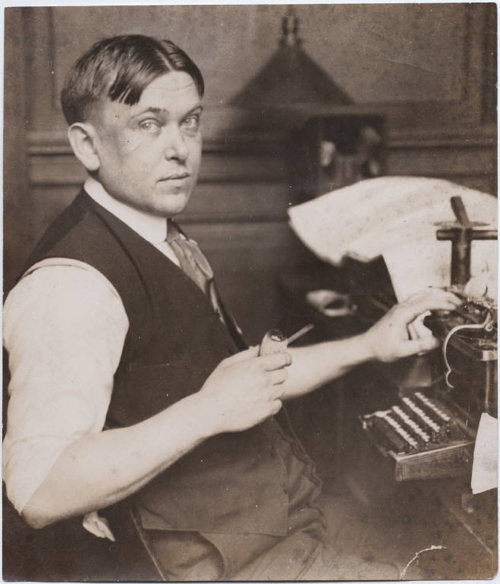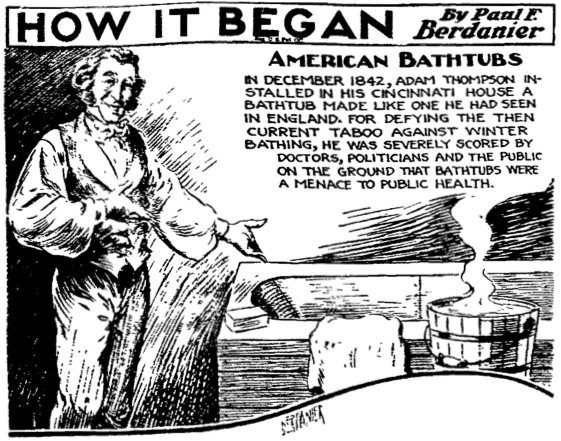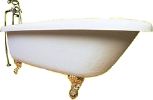On December 28, 1917, the journalist Henry L. Mencken published an article in the New York
Evening Mail titled "A Neglected Anniversary"
(read the full text here). It described the curious history of the bathtub in America, particularly how people, believing bathtubs posed a health risk, were slow to accept them until Millard Fillmore popularized them by installing one in the White House in 1850.
The Article Spreads
After being published in the
Evening Mail, details from Mencken's article soon began to appear in other publications. Many newspapers printed the following abbreviated version of his history:
The Rise of the Bathtub
The first bathtub in the United States was installed in Cincinnati December 20, 1842, by Adam Thompson. It was made of mahogany and lined with sheet lead. At a Christmas party he exhibited and explained it and four guests later took a plunge. The next day the Cincinnati paper devoted many columns to the new invention and it gave rise to violent controversy.
Some papers designated it as an epicurian luxury, other called it undemocratic, as it lacked simplicity in its surroundings. Medical authorities attacked it as dangerous to health.
The controversy reached other cities, and in more than one place medical opposition was reflected in legislation. In 1843 the Philadelphia Common Council considered an ordinance prohibiting bathing between November 1 and March 15, and this ordinance failed of passage by but two votes.
During the same year the Legislature of Virginia laid a tax of $30 a year on all bathtubs that might be set up. In Hartford, Providence, Charleston and Wilmington special and very heavy water rates were laid on persons who had bathtubs. Boston in 1845 made bathing unlawful except on medical advice, but the ordinance was never enforced and in 1862 it was repealed.
President Millard Fillmore gave the bathtub recognition and respectability. While Vice President he visited Cincinnati in 1850 on a stumping tour and inspected the original bathtub and used it. Experiencing no ill effects he became an ardent advocate, and on becoming President he had a tub installed in the White House. The Secretary of War invited bids for the installation. This tub continued to be the one in use until the first Cleveland Administration.
The Joke Succeeds Too Well
Nothing in Mencken's history of the bathtub was true. It was all a joke. Mencken later wrote, "My motive was simply to have some harmless fun in war days."
Mencken said he didn't expect anyone to take his article seriously, but his motives were hardly as innocent as he made them out to be. The article was a deliberate hoax designed to test the gullibility of readers and other journalists. His hoax succeeded beyond his wildest dreams.

H.L. Mencken
Mencken's faux history of the bathtub quickly spread throughout the country. Not only did references to it pop up repeatedly in newspapers, but scholarly histories of public hygiene also cited it, illustrating Lord Balfour's famous quip that, "History does not repeat itself. Historians repeat each other."
Mencken Confesses
After eight years passed, and the faux-history was still circulating, Mencken decided the joke had gone far enough. It was time to reveal what he had done. On May 23, 1926 he wrote a front-page article in the
Chicago Tribune titled "Melancholy Reflections" in which he exposed his deception. Excerpts from this article follow
(read the full text here):
On Dec. 28, 1917, I printed in the New York Evening Mail, a paper now extinct, an article purporting to give the history of the bathtub. This article, I may say at once, was a tissue of absurdities, all of them deliberte and most of them obvious...
This article, as I say, was planned as a piece of spoofing to relieve the strain of war days, and I confess that I regarded it, when it came out, with considerable satisfaction. It was reprinted by various great organs of the enlightenment, and after a while the usual letters began to reach me from readers. Then, suddenly, my satisfaction turned to consternation. For these readers, it appeared, all took my idle jocosities with complete seriousness. Some of them, of antiquarian tastes, asked for further light on this or that phase of the subject. Others actually offered me corroboration!
But the worst was to come. Pretty soon I began to encounter my preposterous "facts" in the writings of other men. They began to be used by chiropractors and other such quacks as evidence of the stupidity of medical men. They began to be cited by medical men as proof of the progress of public hygiene. They got into learned journals. They were alluded to on the floor of congress. They crossed the ocean, and were discussed solemnly in England and on the continent. Finally, I began to find them in standard works of reference. Today, I believe, they are accepted as gospel everywhere on earth. To question them becomes as hazardous as to question the Norman invasion...
I recite this history, not because it is singular, but because it is typical. It is out of just such frauds, I believe, that most of the so-called knowledge of humanity flows. What begins as a guess -- or, perhaps, not infrequently, as a downright and deliberate lie -- ends as a fact and is embalmed in the history books. One recalls the gaudy days of 1914-1918. How much that was then devoured by the newspaper readers of the world was actually true? Probably not 1 per cent. Ever since the war ended learned and laborious men have been at work examining and exposing its fictions. But every one of these fictions retains full faith and credit today. To question even the most palpably absurd of them, in most parts of the United States, is to invite denunciation as a bolshevik...
The moral, if any, I leave to psycho-pathologists, if competent ones can be found. All I care to do today is to reiterate, in the most solemn and awful terms, that my history of the bathtub, printed on Dec. 28, 1917, was pure buncombe. If there were any facts in it they got there accidentally and against my design. But today the tale is in the encyclopedias. History, said a great American soothsayer, is bunk.
The Joke Refuses To Die
Mencken's exposé did little to halt the spread of his faux history of the bathtub. In fact, the Boston
Herald, three weeks after publishing his confession, reprinted details of his fake bathtub history as news. Mencken wrote further articles describing his hoax, such as one published on July 25, 1926, but by now his history had taken on a life of its own and continued to circulate widely as fact. The genie, once let out of the bottle, refused to be put back in.

Illustration of Thompson's bathtub, published in the
Chronicle-Telegram, November 18, 1935 -- nine years after Mencken's confession.
Curtis MacDougall, writing in 1958, reported finding fifty-five different instances since 1926 of Mencken's bathtub history being presented to audiences as fact. Some of the examples that MacDougall collected included:
October, 1926: Scribner's included an article, "Bathtubs, Early Americans," by Fairfax Downey, based almost entirely on Mencken's story.
March 16, 1929: In "Baltimore Day by Day," by Carroll Dulaney, in Mencken's own newspaper, the Baltimore
Evening Sun, the story is told under the heading, "Painting the Lily."
September 26, 1929: The Paris, France, edition of the New York
Herald rewrites an article by Ruth Wakeman in the New York
Sun entitled, "Americans Once Frowned on Bathtubs, Condemning Them for Fancied Hazards."
December 1, 1931: The Tucson, Arizona,
Daily Star interviews C.R. King, manager of the Standard Sanitary Manufacturing Company branch in Tucson, on the imminent birthday of the bathtub. Mr. King, who according to the Star "had apparently studied the matter considerably," hands out the same old facts, which are printed under a two-column head, "Bathtub Will Have Birthday in America During December."
April 27, 1933: A United Features Syndicate feature, "How It Began," by Russ Murphy and Ray Nenuskay includes an illustration of Adam Thompson in his first bathtub.
1935: Dr. Hans Zinsser, professor in the Medical School of Harvard University, says on page 285 of his best-selling
Rats, Lice and History: "The first bathtub didn't reach America, we believe, until about 1840."
November 15, 1935: R.J. Scott's "Scott's Scrapbook," syndicated by the Central Press Asociation, includes a sketch of a policeman chasing a bather away from his bath, together with the caption: As late as 1842 some American cities prohibited the use of bathtubs."
May 27, 1936: Dr. Shirley W. Wynne, former commissioner of health for New York City, uses the "facts" in a radio address, "What Is Public Health?" over WEAF.
February, 1937: The United Press
Red Letter includes a story from Cambridge, Massachusetts, that Dr. Cecil K. Drinker, dean and professor of physiology at the Harvard School of Public Health, has discovered that his great-great-grandmother, Elizabeth Drinker of Philadelphia, had a bathtub in her home as early as 1803, thus disputing Cincinnati's claim to fame for having the first American bathtub. (The Chicago
Daily News used the story March 27, 1937.)
September 28, 1938: Hearst's
American Weekly includes an article, "There's a Lot of History Behind Your Bathtub," by Virginia S. Eiffert, research expert and contributor to
Natural History, official magazine of the American Museum of Natural History, New York City, and other publications. Miss Eiffert's research has uncovered the old stand-by.
Sept. 20, 1942: Julia Spiegelman retold the entire Adam Thompson tale as fact in an article, "Bathtub's United States Centennial" in the Baltimore
Sun, Mencken's own newspaper.
April 28, 1951: In this day's issue of
The New Yorker John Hersey revealed, in a profile on Harry S. Truman, that "the president seemed reluctant to let go of his belief" in the fact that Millard Fillmore introduced the first bathtub into the White House in 1850. President Truman was known to include the spurious facts in the "lecture" he gave visitors to the renovated executive mansion.
Sept. 16, 1952: In a speech in Philadelphia, President Truman told the story to illustrate what great progress has occurred in public health.
The Hoax Continues
Mencken's faux history of the bathtub is one of the most notorious media hoaxes of the twentieth century. Nevertheless, despite being repeatedly debunked, it continues to be repeated as fact to this day.
For instance, as recently as February, 2004, the Washington Post noted in a travel column, "Bet you didn't know that . . . Fillmore was the first president to install a bathtub in the White House." It sheepishly ran a correction a few days later.
The website
sniggle.net has cataloged thirty-four other examples of Mencken's bathtub history being offered as fact in recent articles.
The Real History of the Bathtub
Bathing has been a popular practice for thousands of years. The Romans built marble baths complete with lead or bronze pipes. However, modern bathtubs, fitted with plumbing, and installed in houses, were a nineteenth-century innovation. Cast-iron bathtubs began to be sold during the 1880s. By the early 20th century it had become common for houses to have separate bathrooms in which a bathtub was installed. Despite what Mencken claimed, medical authorities did not denounce bathing as unhygienic. Nor were laws passed banning the practice.
Celebrations
In honor of Millard Fillmore's apocryphal adoption of the bathtub, the town of Moravia, New York has held bathtub races down its main street every year since 1975. The races are part of a celebration which it calls Fillmore Days.
Links and References
- "The Rise of the Bathtub." (June 30, 1920). The Clearfield Progress. Pg. 2.
- Mencken, H.L. (May 23, 1926). "Melancholy Reflections." Chicago Sunday Tribune: 1.
- MacDougall, Curtis. (1958). Hoaxes. Dover Publications: 302-309.
- "Presidents' Day 101" (February 15, 2004). The Washington Post. Travel: P02.
- "Millard Fillmore's Bathtub." Sniggle.net.




Comments
Damp baths are to be eschewed except by the rich, whose diet is more refined and includes hot and dry things like good wines, strong spices, hares, partridges, and pheasants. And this in summer only, for in winter I would advise them to abstain from ordinary baths entirely.
-- Francis Raspard, 1551
Bruges physician, A Great and Perpetual Almanach
From The Experts Speak, Page 30
It may be that this was a relatively common view of medical people for some time so medical doctors may have had a reason to believe Mencken's story on that part.
Not sure how people at that time weren't aware that baths (including private baths) hadn't been around for thousands of years. Although, they were generally restricted to wealthier homes. Of course, there were public baths in some places.